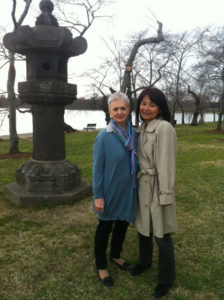Off to Japan, in Eliza Scidmore’s Footsteps

By the Tidal Basin in Washington with reporter Miki Ebara, in front of the first two cherry trees from Japan planted on March 27, 1912, and a 300-year-old lantern from Japan (Source: NHK TV)
A busy Saturday. I just spent five hours with a film crew from the New York bureau of Japan’s NHK television, talking about my research on Eliza Scidmore.
Miki Ebara, the chief correspondent in New York, first contacted me a year ago, not long after I launched this blog (previously as “A Great Blooming”). She covers disasters as part of her reporting duties and was familiar with Eliza Scidmore’s article in National Geographic on a deadly 1896 tsunami on the northeast coast of Japan.
Miki and I reconnected several weeks ago when I started planning a research trip to Japan. The trip came together quickly when I realized I needed to be in Japan during cherry blossom season.
It was my first trip to Japan, and I worried about language difficulties and logistics. But Miki stepped in and provided wonderful guidance.
Because she shares my fascination with Scidmore, Miki decided to do a news feature on the cherry trees in Washington. It includes a segment on my research about Eliza Scidmore. The show will air on March 30, when the trees in Japan should be at peak bloom.
Scidmore is fairly well known in Japan because of her book Jinrikisha Days in Japan and her role in bringing cherry trees to Washington. She’s buried in Yokohama — a major reason why I need to go. There’s a plaque about her posted outside one of Yokohama’s metro stations, near the cemetery where she’s buried.
 Miki has been a great go-between, arranging connections with people in Japan who may know something about Eliza.
Miki has been a great go-between, arranging connections with people in Japan who may know something about Eliza.
Among other things, I plan to visit Scidmore’s gravesite and do research at the Yokohama Archives of History. The archives has records of several English-language newspapers that may offer clues to Scidmore’s comings and goings in Japan in the late 1800s and early 1900s.
It will be exciting to compare notes with other Eliza-philes and to walk in her footsteps. I’ve discovered, for example, that she and her mother had a home in Yokohama on the Bund, the main avenue overlooking the harbor.
This trip is going to be very fruitful. Thanks, Miki!
Hi Diana, I’ve been to Yokohama several times and walked the streets and piers. Beautiful seaport and very underrated. So happy to hear about your work and get a sense of your passion for it! Look forward to reading more about it. Loey
Hi, Lois. What a coincidence! Through my research I’ve gotten a strong sense of the port in the 1880s. I know it’s changed a lot today, of course, so it will be interesting to see it through double vision. Just read a haunting book about the huge earthquake that leveled the city on Sept. 1, 1923. Diana
I so happy for you and excited for what you may discover. Have a wonderful, productive trip.